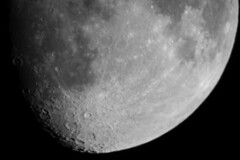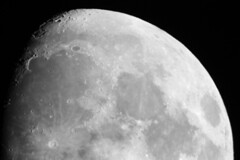
Photos by Samantha Saville: Pictures of the moon were taken though Dr. Astalos telescope set up at the Planet Watch event last Saturday
Samantha Saville
The Paw Print
On Saturday night a record high number of participates gathered at the planetarium for the “Planet Watch” program directed by Dr. Astalos.
The night consisted of two shows at 6 p.m. and 7:30 p.m. with telescopes out for viewing from 6 to 9 p.m.
By the start of each show it was standing room only with around 156 community members and students coming to learn about the visible planets.
During these shows Astalos showed the program Stellarium that is an interactive program of the sky. Astalos showed participants the sky in Alamosa to see what the planets will be doing for the next few weeks at different times.
There were a total of six telescopes out for people to look through. Two were set up to view the moon, and one set up to view Mars, Jupiter, Venus and Mercury when it was visible. These telescopes were run by ASC students form the astronomy club and students from Astalos’ astronomy class. The night was full of rare events. Four planets were visible at one time, with five planets being visible throughout the night, at 6:27 p.m. the international space station currently holding six astronauts passed visibly in the sky between Venus and Jupiter. This was a beautiful sight that everyone seemed to enjoy.
Jupiter and Venus were visible before sunset in the western sky. Venus is the lower bright star visible with Jupiter the bright one above it. In the next few weeks these planets will be getting closer together as Venus rises in the sky and Jupiter setting. Around March 15 they will be the closest in there cycle. Looking at Jupiter in the telescope viewers could see all four of its Galilean moons very clearly which does not always happen.
Mercury joined them in the western sky for a short time just after sunset. Mercury was in the sky longer than just after sunset but the light pollution form the sun made it impossible to see until the sun was set. It was visible through the telescopes around 7 p.m. just above the mountains directly west. It set shortly after.
Looking toward the east you could see Mars the reddish looking star in the eastern sky.
One telescope was set up to view this planet for the night but since it was rising it was moving quickly which made it hard to keep in the line of view.
Also during the night the sky clouded over blocking the view for the participants. Luckily it cleared up for the second show so Mars was visible again.
Saturn rose about 10 p.m. in the eastern sky joining Mars. Looking at Saturn through a telescope allows viewers to see its rings very clearly, which is not always possible.
The planetarium show ended around 9 p.m.
More information on the planets or the stars will be made available for future events.

Photo by Samantha Saviile
What’s Been Said…